Button Lancia Ypsilon 2003 Owner handbook (in English)
[x] Cancel search | Manufacturer: LANCIA, Model Year: 2003, Model line: Ypsilon, Model: Lancia Ypsilon 2003Pages: 191, PDF Size: 2.45 MB
Page 47 of 191
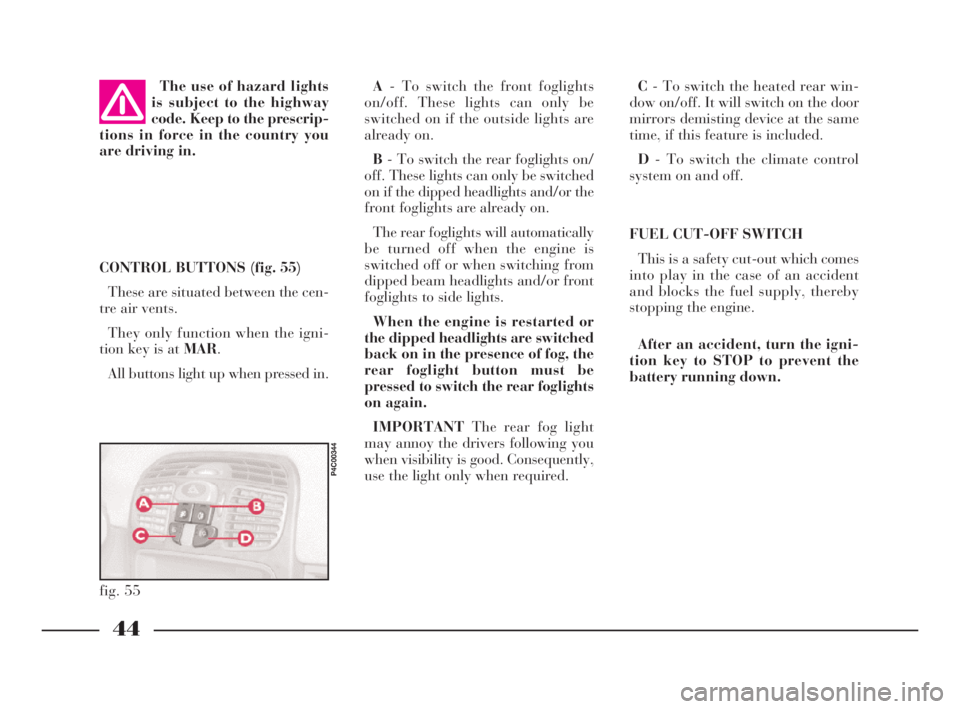
44
G
C- To switch the heated rear win-
dow on/off. It will switch on the door
mirrors demisting device at the same
time, if this feature is included.
D- To switch the climate control
system on and off.
FUEL CUT-OFF SWITCH
This is a safety cut-out which comes
into play in the case of an accident
and blocks the fuel supply, thereby
stopping the engine.
After an accident, turn the igni-
tion key to STOP to prevent the
battery running down. CONTROL BUTTONS (fig. 55)
These are situated between the cen-
tre air vents.
They only function when the igni-
tion key is at MAR.
All buttons light up when pressed in. The use of hazard lights
is subject to the highway
code. Keep to the prescrip-
tions in force in the country you
are driving in.
fig. 55
P4C00344
A- To switch the front foglights
on/off. These lights can only be
switched on if the outside lights are
already on.
B- To switch the rear foglights on/
off. These lights can only be switched
on if the dipped headlights and/or the
front foglights are already on.
The rear foglights will automatically
be turned off when the engine is
switched off or when switching from
dipped beam headlights and/or front
foglights to side lights.
When the engine is restarted or
the dipped headlights are switched
back on in the presence of fog, the
rear foglight button must be
pressed to switch the rear foglights
on again.
IMPORTANTThe rear fog light
may annoy the drivers following you
when visibility is good. Consequently,
use the light only when required.
4C001-067 ING 11-03-2008 11:57 Pagina 44
Page 49 of 191

46
G
sition and the cigar lighter is ready to
use.
The ashtray can be removed.
IMPORTANTMake sure that the
cigar lighter does in fact pop out af-
ter it has been pushed in.
The rear seats have a concealed ash-
tray in the right side panel.
Follow the direction of the arrow to
use and extract the ashtray (fig. 61).
fig. 61
P4C00099
CEILING LAMP (fig. 59)
SwitchesAandBswitch the ceiling
lights on and off.
The following conditions are created
according to the position of these
switches:
–with switch A in the centre po-
sition, light Cin the ceiling lamp will
come on when the doors are opened;
–with switch A moved to the left,
lightCin the ceiling lamp is off and
will not light up if the doors are
opened;
–with switch A moved to the
right, light Cin the ceiling lamp will
light up regardless of whether the
doors are open or not.SwitchBwill switch the map-read-
ing light Don/off (spot light).
IMPORTANTBefore getting out of
the car, make sure that switch Ais in
the centre position; the ceiling light will
then go out when the doors are closed
and you will not drain the battery.
ASHTRAY AND CIGAR LIGHTER
How to use them:
1)Open flap A (fig. 60)in the di-
rection of the arrow to reach the cigar
lighter and the ashtray.
2)Press button B: after around fif-
teen seconds it returns to its initial po-
fig. 60
P4C00215
fig. 59
P4C00097
4C001-067 ING 11-03-2008 11:57 Pagina 46
Page 51 of 191

48
G
A key C (fig. 67)is attached to the
back of the cover B (fig. 67); insert
this key into D (fig. 68) and turn it to
manually perform the operations de-
scribed previously (opening/closing).
To reach D, remove the press-fitted
cover.
fig. 68
P4C00187
Do not open the roof if
there is snow or ice on it as
you risk damaging it.
SUNROOF
The sunroof is electrically operated.
It will only work if the ignition key
is at MAR.
ButtonA (fig. 65)on the ceiling light
unit controls the opening, closing,
raising and lowering of the roof.
When you release the button, the
roof locks in the position it is in at
that moment.
£Press once to open in the spoiler
position.
Press again to open completely.
¢Press to close.
fig. 65
P4C00101
A sliding sunshade, fitted under the
sunroof, will lessen the effect of the
sun’s rays or the amount of air enter-
ing the car (fig. 66).
If there is an electrical fault in the
sunroof, open the glove compartment.
fig. 66
P4C00102
fig. 67
P4C00103
4C001-067 ING 11-03-2008 11:57 Pagina 48
Page 53 of 191
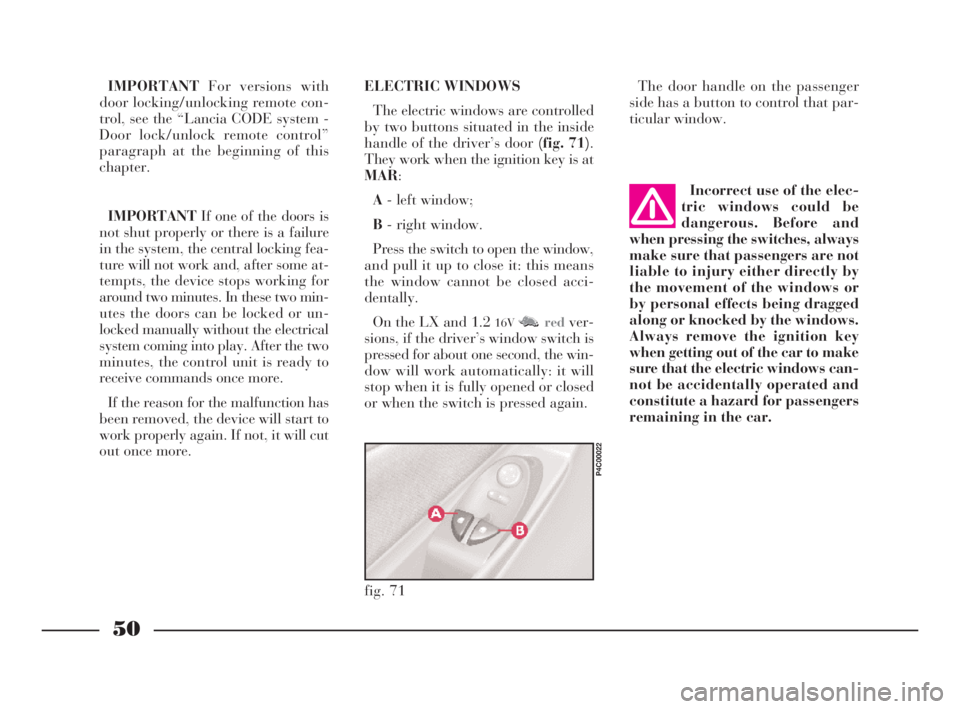
50
G
Incorrect use of the elec-
tric windows could be
dangerous. Before and
when pressing the switches, always
make sure that passengers are not
liable to injury either directly by
the movement of the windows or
by personal effects being dragged
along or knocked by the windows.
Always remove the ignition key
when getting out of the car to make
sure that the electric windows can-
not be accidentally operated and
constitute a hazard for passengers
remaining in the car.
The door handle on the passenger
side has a button to control that par-
ticular window. IMPORTANTFor versions with
door locking/unlocking remote con-
trol, see the “Lancia CODE system -
Door lock/unlock remote control”
paragraph at the beginning of this
chapter.
IMPORTANTIf one of the doors is
not shut properly or there is a failure
in the system, the central locking fea-
ture will not work and, after some at-
tempts, the device stops working for
around two minutes. In these two min-
utes the doors can be locked or un-
locked manually without the electrical
system coming into play. After the two
minutes, the control unit is ready to
receive commands once more.
If the reason for the malfunction has
been removed, the device will start to
work properly again. If not, it will cut
out once more.ELECTRIC WINDOWS
The electric windows are controlled
by two buttons situated in the inside
handle of the driver’s door (fig. 71).
They work when the ignition key is at
MAR:
A- left window;
B- right window.
Press the switch to open the window,
and pull it up to close it: this means
the window cannot be closed acci-
dentally.
On the LX and 1.2
16VM M Nredver-
sions, if the driver’s window switch is
pressed for about one second, the win-
dow will work automatically: it will
stop when it is fully opened or closed
or when the switch is pressed again.
fig. 71
P4C00022
4C001-067 ING 11-03-2008 11:57 Pagina 50
Page 55 of 191

52
G
4)Fold the seat back forwards to
make a flat loading surface with the
boot floor (fig. 78).
If necessary, the cushion can also be
tilted(fig. 79). Consequently, before
releasing the seat back, lift the cush-
ion as shown and tip it against the
front seat backs; the rear seat back-
rest can then be released and tilted
forwards.
To return the seat to its normal po-
sition:
1)Return the seat back to the verti-
cal position and make sure it is prop-
erly locked into place; the red strip on
the hook-up button must disappear.
fig. 77
P4C00034
Removing the parcel shelf
If you wish to remove the parcel
shelf to extend the boot capacity, un-
hook the two tie-rods (one each side)
A (fig. 75)from the hooks B, then
pull the parcel shelf outwards so that
pinsCcome out.
The shelf can then be positioned be-
hind the front seats.INCREASING THE LOAD AREA
Proceed as follows:
1)Make sure that the side seat belts
A (fig. 76)have been inserted into the
corresponding bracket B.
2)Remove the rear head restraints
if required.
3)Release the seat back by pressing
buttonA (fig. 77)(one for each side)
located on the back seat back-rest
(even when a split back seat is fitted);
a red strip will appear on the short
side of the button (towards the inside
of the car) to indicate that it has been
released.
fig. 75
P4C00009
fig. 76
P4C00052
Heavy loads which are
not securely anchored
could seriously injure pas-
sengers in the event of an accident.
4C001-067 ING 11-03-2008 11:57 Pagina 52
Page 74 of 191
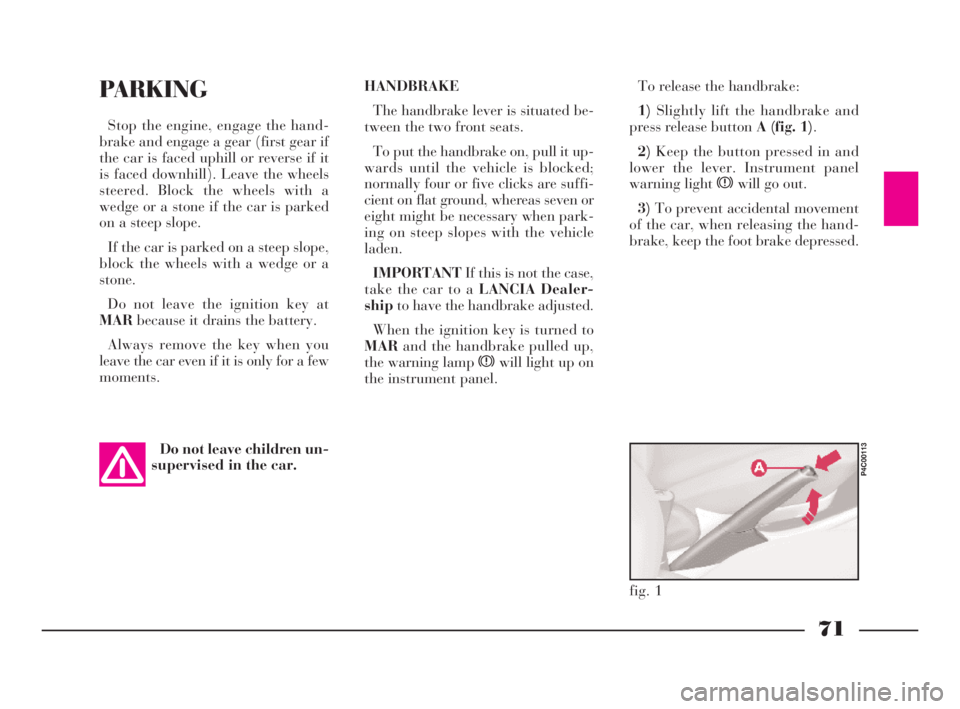
71
G
HANDBRAKE
The handbrake lever is situated be-
tween the two front seats.
To put the handbrake on, pull it up-
wards until the vehicle is blocked;
normally four or five clicks are suffi-
cient on flat ground, whereas seven or
eight might be necessary when park-
ing on steep slopes with the vehicle
laden.
IMPORTANTIf this is not the case,
take the car to a LANCIA Dealer-
shipto have the handbrake adjusted.
When the ignition key is turned to
MARand the handbrake pulled up,
the warning lamp xwill light up on
the instrument panel.To release the handbrake:
1)Slightly lift the handbrake and
press release button A (fig. 1).
2)Keep the button pressed in and
lower the lever. Instrument panel
warning light xwill go out.
3)To prevent accidental movement
of the car, when releasing the hand-
brake, keep the foot brake depressed.PARKING
Stop the engine, engage the hand-
brake and engage a gear (first gear if
the car is faced uphill or reverse if it
is faced downhill). Leave the wheels
steered. Block the wheels with a
wedge or a stone if the car is parked
on a steep slope.
If the car is parked on a steep slope,
block the wheels with a wedge or a
stone.
Do not leave the ignition key at
MARbecause it drains the battery.
Always remove the key when you
leave the car even if it is only for a few
moments.
Do not leave children un-
supervised in the car.
fig. 1
P4C00113
4C068-089 ING 11-03-2008 11:59 Pagina 71
Page 128 of 191
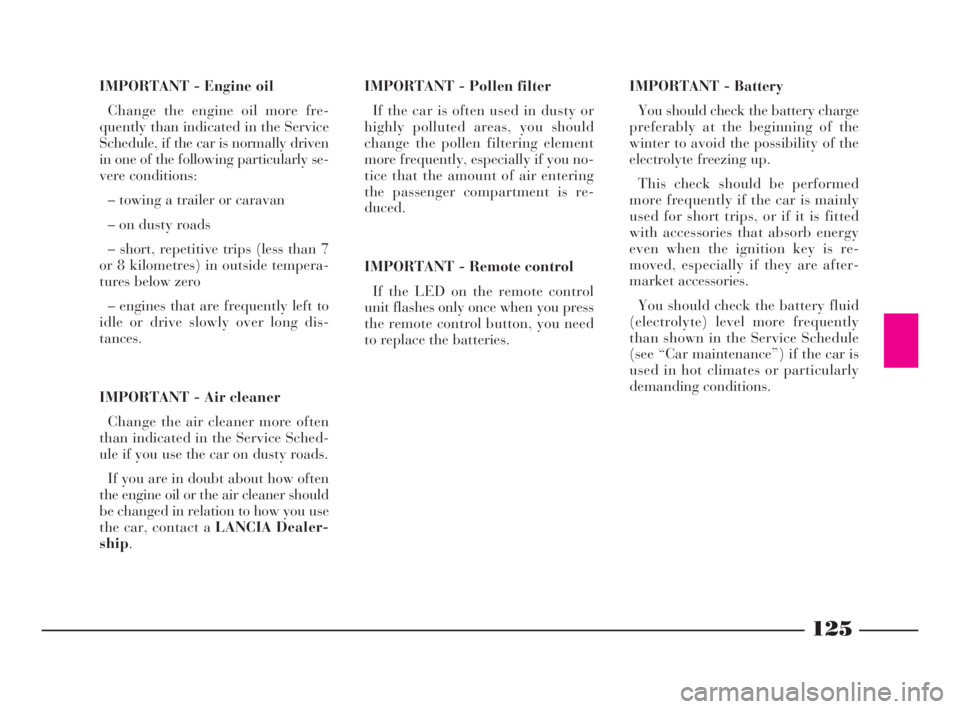
125
G
IMPORTANT - Battery
You should check the battery charge
preferably at the beginning of the
winter to avoid the possibility of the
electrolyte freezing up.
This check should be performed
more frequently if the car is mainly
used for short trips, or if it is fitted
with accessories that absorb energy
even when the ignition key is re-
moved, especially if they are after-
market accessories.
You should check the battery fluid
(electrolyte) level more frequently
than shown in the Service Schedule
(see “Car maintenance”) if the car is
used in hot climates or particularly
demanding conditions. IMPORTANT - Engine oil
Change the engine oil more fre-
quently than indicated in the Service
Schedule, if the car is normally driven
in one of the following particularly se-
vere conditions:
– towing a trailer or caravan
– on dusty roads
– short, repetitive trips (less than 7
or 8 kilometres) in outside tempera-
tures below zero
– engines that are frequently left to
idle or drive slowly over long dis-
tances.
IMPORTANT - Air cleaner
Change the air cleaner more often
than indicated in the Service Sched-
ule if you use the car on dusty roads.
If you are in doubt about how often
the engine oil or the air cleaner should
be changed in relation to how you use
the car, contact a LANCIA Dealer-
ship.IMPORTANT - Pollen filter
If the car is often used in dusty or
highly polluted areas, you should
change the pollen filtering element
more frequently, especially if you no-
tice that the amount of air entering
the passenger compartment is re-
duced.
IMPORTANT - Remote control
If the LED on the remote control
unit flashes only once when you press
the remote control button, you need
to replace the batteries.
4C120-143 ING 11-03-2008 12:01 Pagina 125
Page 180 of 191
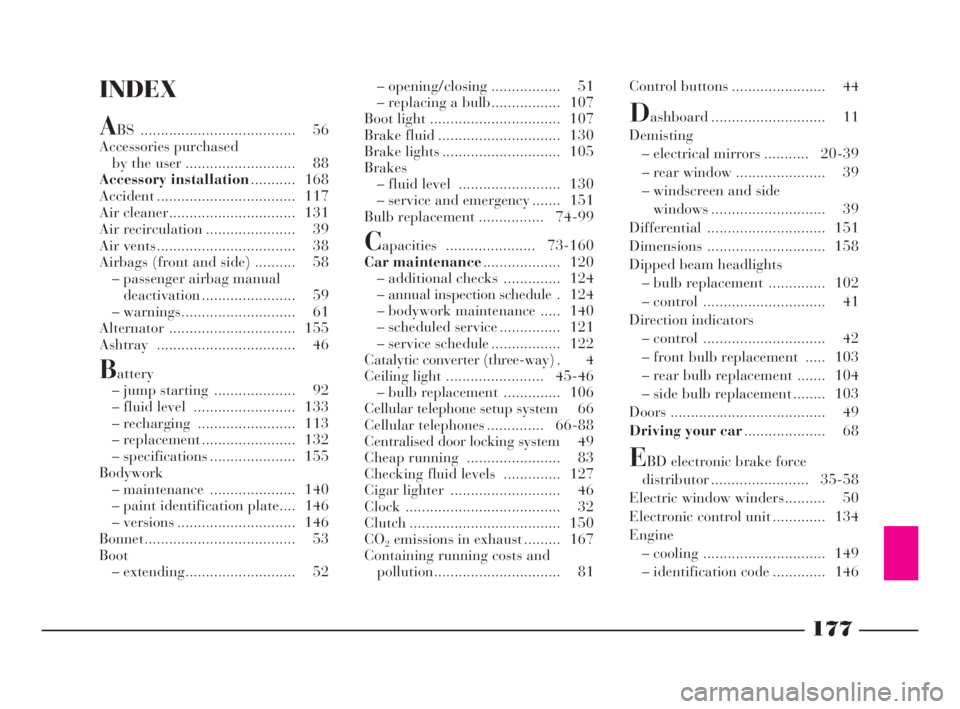
177
fdG
INDEX
ABS ...................................... 56
Accessories purchased
by the user ........................... 88
Accessory installation........... 168
Accident .................................. 117
Air cleaner............................... 131
Air recirculation ...................... 39
Air vents.................................. 38
Airbags (front and side) .......... 58
– passenger airbag manual
deactivation ....................... 59
– warnings............................ 61
Alternator ............................... 155
Ashtray .................................. 46
Battery
– jump starting .................... 92
– fluid level ......................... 133
– recharging ........................ 113
– replacement ....................... 132
– specifications ..................... 155
Bodywork
– maintenance ..................... 140
– paint identification plate.... 146
– versions ............................. 146
Bonnet..................................... 53
Boot
– extending........................... 52– opening/closing ................. 51
– replacing a bulb................. 107
Boot light ................................ 107
Brake fluid .............................. 130
Brake lights ............................. 105
Brakes
– fluid level ......................... 130
– service and emergency ....... 151
Bulb replacement ................ 74-99
Capacities ...................... 73-160
Car maintenance................... 120
– additional checks .............. 124
– annual inspection schedule . 124
– bodywork maintenance ..... 140
– scheduled service ............... 121
– service schedule ................. 122
Catalytic converter (three-way) . 4
Ceiling light ........................ 45-46
– bulb replacement .............. 106
Cellular telephone setup system 66
Cellular telephones .............. 66-88
Centralised door locking system 49
Cheap running ....................... 83
Checking fluid levels .............. 127
Cigar lighter ........................... 46
Clock ...................................... 32
Clutch ..................................... 150
CO
2emissions in exhaust ......... 167
Containing running costs and
pollution............................... 81Control buttons ....................... 44
Dashboard ............................ 11
Demisting
– electrical mirrors ........... 20-39
– rear window ...................... 39
– windscreen and side
windows ............................ 39
Differential ............................. 151
Dimensions ............................. 158
Dipped beam headlights
– bulb replacement .............. 102
– control .............................. 41
Direction indicators
– control .............................. 42
– front bulb replacement ..... 103
– rear bulb replacement ....... 104
– side bulb replacement ........ 103
Doors ...................................... 49
Driving your car.................... 68
EBD electronic brake force
distributor ........................ 35-58
Electric window winders.......... 50
Electronic control unit ............. 134
Engine
– cooling .............................. 149
– identification code ............. 146
4C177-184 Indice ING 13-03-2008 13:31 Pagina 177
Page 181 of 191
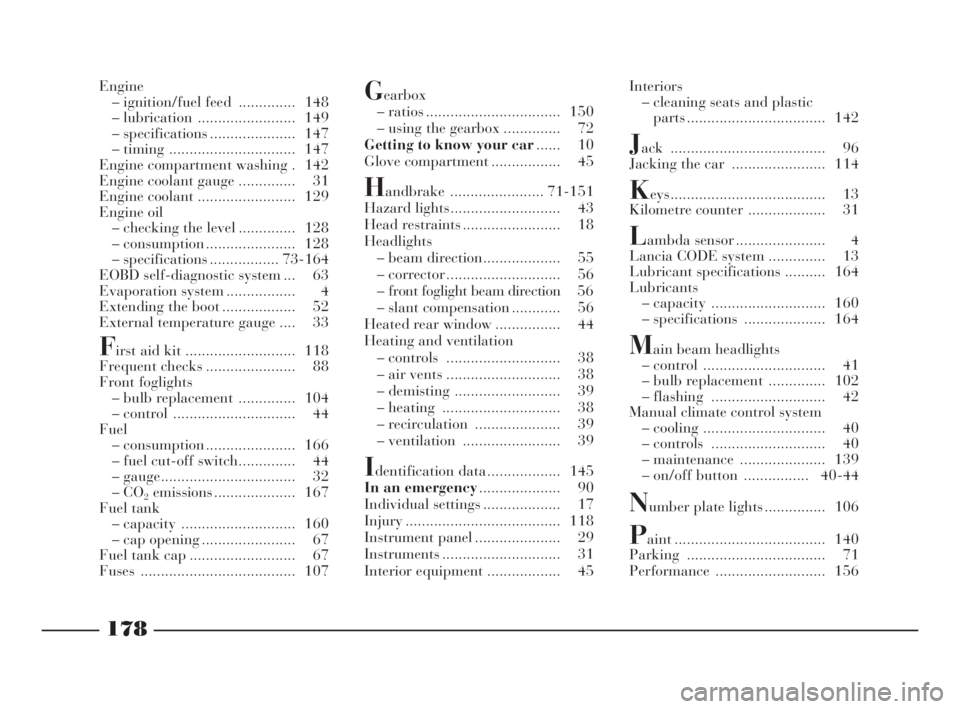
178
fdG
Interiors
– cleaning seats and plastic
parts .................................. 142
Jack ...................................... 96
Jacking the car ....................... 114
Keys...................................... 13
Kilometre counter ................... 31
Lambda sensor ...................... 4
Lancia CODE system .............. 13
Lubricant specifications .......... 164
Lubricants
– capacity ............................ 160
– specifications .................... 164
Main beam headlights
– control .............................. 41
– bulb replacement .............. 102
– flashing ............................ 42
Manual climate control system
– cooling .............................. 40
– controls ............................ 40
– maintenance ..................... 139
– on/off button ................ 40-44
Number plate lights ............... 106
Paint ..................................... 140
Parking .................................. 71
Performance ........................... 156 Engine
– ignition/fuel feed .............. 148
– lubrication ........................ 149
– specifications ..................... 147
– timing ............................... 147
Engine compartment washing . 142
Engine coolant gauge .............. 31
Engine coolant ........................ 129
Engine oil
– checking the level .............. 128
– consumption ...................... 128
– specifications ................. 73-164
EOBD self-diagnostic system ... 63
Evaporation system ................. 4
Extending the boot .................. 52
External temperature gauge .... 33
First aid kit ........................... 118
Frequent checks ...................... 88
Front foglights
– bulb replacement .............. 104
– control .............................. 44
Fuel
– consumption ...................... 166
– fuel cut-off switch.............. 44
– gauge................................. 32
–CO
2emissions .................... 167
Fuel tank
– capacity ............................ 160
– cap opening ....................... 67
Fuel tank cap .......................... 67
Fuses ...................................... 107
Gearbox
– ratios ................................. 150
– using the gearbox .............. 72
Getting to know your car...... 10
Glove compartment ................. 45
Handbrake ....................... 71-151
Hazard lights........................... 43
Head restraints ........................ 18
Headlights
– beam direction................... 55
– corrector ............................ 56
– front foglight beam direction 56
– slant compensation ............ 56
Heated rear window ................ 44
Heating and ventilation
– controls ............................ 38
– air vents ............................ 38
– demisting .......................... 39
– heating ............................. 38
– recirculation ..................... 39
– ventilation ........................ 39
Identification data .................. 145
In an emergency.................... 90
Individual settings ................... 17
Injury ...................................... 118
Instrument panel ..................... 29
Instruments ............................. 31
Interior equipment .................. 45
4C177-184 Indice ING 13-03-2008 13:31 Pagina 178